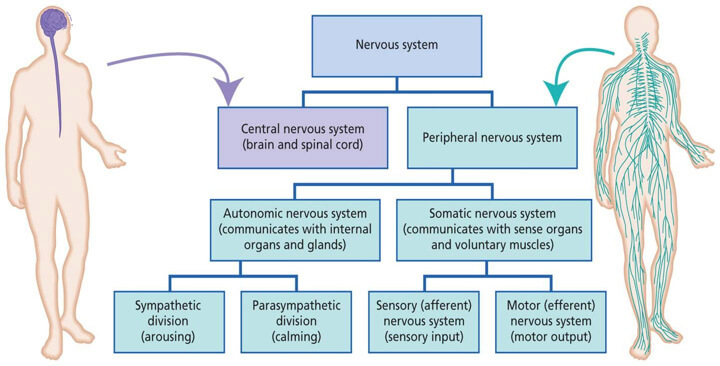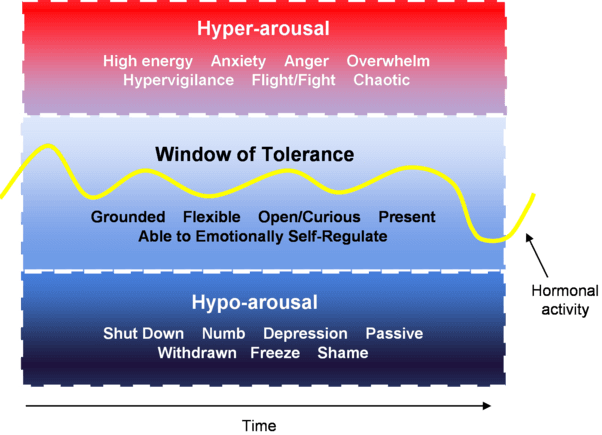This website uses cookies so that we can provide you with the best user experience possible. Cookie information is stored in your browser and performs functions such as recognising you when you return to our website and helping our team to understand which sections of the website you find most interesting and useful.
What is Trauma (Pt. 9) – In Your Brain & Body (3 of 3)

Today I’m talking about how trauma wires into your brain and body. Specifically about how trauma stores in your body (ie. your nervous system).
Laura
- April 9, 2024
Today we’re continuing our series on Trauma, by finishing our discussion on the science of how trauma wires into your brain and body. Specifically, we’re talking about how trauma stores in your body (ie. your nervous system).
This series is here to help you understand what trauma is, what the signs and symptoms are, and how and why God created you in a way that includes trauma. We’ll cover the basics of this mental health dysfunction, all the way into some of the science of how it wires into your memories and nervous system. This will give you the foundation for understanding how to heal any trauma you may be carrying. Because trauma is one of the main causes of stress in life as a human.
This is the 9th in a series of 10 posts called “What is Trauma”. Learning about trauma can be overwhelming and even triggering. I encourage you to go slow, letting God lead you to where He needs you right now. And if at any point your get triggered and need help, there are free and paid resources linked at the bottom of each post. They’ll help you out of those triggers, back into the state of peace in your mind and body. You deserve that, so don’t shy away from help if you need it. I’m praying for you.
In Your Brain & Body
Today I’m continuing our discussion on the science of how trauma wires into your brain and body. Specifically, I’m talking about how trauma stores in your body (ie. your nervous system).
If you missed the previous posts, I talked about how trauma wires into your survival brain (limbic system creating triggers), your memories and your belief systems. I also introduced what trauma is, what the 5 different types of trauma are (Acute, Chronic, and Secondary, and Developmental, Complex and Complex PTSD). As well as what the signs and symptoms of trauma are (the main types, dissociation, and ACEs). These are great introductions into trauma and it’s symptoms, which will help understand the science we’re going to talk about today.
How Your Nervous System Changes with Trauma
To understand how trauma changes your body (in this case your nervous system), you first need to understand how God designed your nervous system.
How God Designed Your Nervous System
God designed your nervous system to be the communication lines between your brain and body. Your brain acts like an operating system, making decisions for you in your thoughts and actions; just like the operating system of your computer. Your nervous system is the part of you that delivers the message from your brain to the rest of your body, to act according to your brain’s instructions.
If your brain says rest, your nervous system tells your body’s organs and bodily systems to settle into a deep relaxation. If your brain says run, your nervous system tells your body’s organs and bodily systems to gear up with adrenaline, cortisol, oxygen and a fast heart rate to run.
BRANCHES OF YOUR NERVOUS SYSTEM
Your nervous system is an elaborate system running through your entire body, connecting your brain to all of your organs and bodily systems. It has many branches, helping it complete these necessary tasks and functions as the messenger for your brain.

It’s main 2 branches include your central nervous system and your peripheral nervous system. Your central nervous system branch controls your brain and spinal cord, and your peripheral nervous system branch controls everything else in your body (extending out from your spinal cord into your limbs).
Your peripheral nervous system branch then splits into 2 more branches: your autonomic nervous system and your somatic nervous system. Your autonomic nervous system branch controls your internal organs and glands, and your somatic nervous system branch controls your sensory organs and voluntary muscles.
Your autonomic nervous system branch then splits into 2 more branches: your sympathetic nervous system branch and your parasympathetic nervous system branch. Your sympathetic nervous system branch controls your activity (like movement, exercise, running and fighting), and your parasympathetic controls your rest (like sleeping, lounging, and freezing when afraid).
It’s your autonomic nervous system that is responsible for your peace and stress (including your trauma).
YOUR AUTONOMIC NERVOUS SYSTEM
Your sympathetic nervous system branch will be active when you’re awake, up moving around and exercising. Your parasympathetic nervous system branch will be active when you’re resting, lounging and sleeping.
Throughout your day, your autonomic nervous system will shift back and forth between your sympathetic and parasympathetic branches, to signal to your body to rest and move as your brain tells it too.
In a perfect sin-less world, you would move between these 2 sets of functions in a stress-free way. Since we live in a fallen world with danger, your nervous system has 2 additional functions to keep you safe and alive.
YOUR NERVOUS SYSTEM WITH STRESS
When your brain senses danger (physically, mentally, emotionally and/or spiritually), it will signal to your nervous system to react accordingly. Your sympathetic and parasympathetic nervous system branches move you into the survival mode states of fight, flight or freeze to keep you safe and alive.
Your sympathetic nervous system branch will shift you into the survival mode state of fight or flight, to help you fight or run away from the danger. This state is an exaggerated form of movement and exercise, that I like to call hulk- or beast-mode. Your body will be flooded with enough adrenaline and cortisol (stress hormones) to allow you to run 80mph and outrun a wild animal (or attacker).
Your parasympathetic nervous system branch will shift you into the survival mode state of freeze, to help you go numb and collapse (a form of shutdown), so you can get through the danger without feeling all of it. This state is an exaggerated form of rest and sleep, that is a temporary paralysis. Your body will be flooded with enough endorphins to keep you from feeling the bite of a wild animal (or pain from an attacker).
WINDOW OF TOLERANCE
Your nervous system has a threshold called the window of tolerance. This is the window where your nervous system can operate normally, regardless of what stressful things you experience. Outside of this window is where your nervous system operates in the survival mode states of fight, flight and freeze. Things in your external world are perceived as dangerous, and your brain and nervous system shift your body into survival mode to stay alive.

Hyper-arousal is when your nervous system is in high gear, trying to fight or run away from the danger and survive. It’s in an over-exaggerated form of activity.
Hypo-arousal is when your nervous system is in low gear, trying to shutdown and go numb so that you don’t have to feel what’s about to happen to you. It’s in an over-exaggerated form of rest.
The window of tolerance is where you’re designed to live, as you interact with the world around you. It’s where you can experience both good and hard situations, while remaining in control of your emotions. When you live in this window, you have a regulated nervous system (meaning you can regulate your stress and emotions).
The arousal zones (both hyper and hypo) are where you’re designed to survive danger, temporarily. They’re where you can experience hard, even life-threatening situations in the world around you; and fight, run away from or shutdown to survive them. You won’t have control over your emotions, and that’s ok. You don’t need to control your emotions when you’re trying to stay alive. When you’re in either of these zones, you have a dysregulated nervous system (meaning you can’t regulate your stress and emotions).
How Trauma Changes Your Nervous System
When you go through something life-altering or life-threatening, and your brain wounds with trauma, it changes the way your nervous system functions.
WINDOW OF TOLERANCE
Once your nervous system has lived in the arousal zones to survive danger (either hyper with sympathetic activation, or hypo with parasympathetic shutdown), it can get stuck in these states.
During the danger, your nervous system will dysregulate to survive. When there’s trauma, it doesn’t always come back to a regulated, healthy state within the window of tolerance (as you’d think it would).
When this happens, you may experience yourself living in these hyper- or hypo-aroused states all of the time.
With hyper-arousal (sympathetic – fight or flight), you may find that you’re stuck being on-edge, scared or angry all the time. When you experience something hard or scary that would initiate larger emotions, you get overwhelmed and can’t handle it.
With hypo-arousal (parasympathetic – freeze), you may find that you’re stuck being disconnected, depressed or even submissive all the time. When you experience something hard or scary that would initiate larger emotions, you shutdown and can’t handle it.
SHAKING OFF THE SURVIVAL RESPONSE
When you go into survival mode (fight, flight or freeze), your body changes to allow you to fight, run away from or freeze during the danger (and survive). These changes include physiological changes to many organs and bodily systems, along with endocrine changes of increased stress hormones (like cortisol and adrenaline).
These changes give your body the necessary energy to fight or run the danger (and win), or shutdown and collapse (and not feel anything from it).
We call these changes your fight, flight or freeze response.
God designed your body to burn off, or use up, all of that energy during the fighting or fleeing. When you freeze, all of that energy gets trapped inside of you, and is part of your trauma.
We see God’s design for this response in wild animals (specifically mammals). When a wild animal goes through a life-threatening situation (like a gazelle being chased by a cheetah), it will react by either fighting or fleeing the danger, until it’s safe. As it does so, it will burn off all of the energy from the fight, flight or freeze response.
If it has any energy from this response left in it’s body, after finding safety, it will begin to shake uncontrollably. The shaking burns off all of the remaining energy from their body, and their nervous system is able to go back into a regulated state (the window of tolerance).
Once all of the energy has been burned off, the animal will walk away as if nothing happened. No trauma.
As a human, you may not have had the ability to fight or run (and win against) the danger you’re facing. Your brain and body might have decided that freeze was the safest response for you to survive. When this happened, all of that fight or flight energy got bottled up inside of you. The message from your brain to fight or run (at this extreme rate), got stuck in your nervous system. That response, now trapped in your body, is your trauma, keeping you stuck in the state of dysregulation.
When an animal can’t release this energy safely, they typically die. When a human can’t release this energy safely, it typically shows up as mental and/or physical illness (like trauma).
DAILY EFFECTS
When your nervous system is stuck in the state of dysregulation, you’ll feel the effects of that stress response daily in your life.
Your body will be turbo-charged with enough energy to run 80mph and outrun a cheetah (or fight it and win). Your hyper- or hypo-aroused states will come with all the big emotions that are normal with these responses. You’ll have an increased amount of stress hormones active in your body, keeping you on-edge all the time.
Where you may have been calm and peaceful before the trauma, you may now be filled with stress and anxiety, possibly hostility and anger. Even if you know logically that you’re safe, that the danger is over, your body may be telling you a different story.
If your brain and nervous system stay locked in this dysregulated state for too long, becoming chronic, your trauma can become post-traumatic stress disorder (PTSD).
The Good News
When you heal your trauma, your nervous system will release all of these stuck responses. It will come out of it’s dysregulated state of hyper- or hypo-arousal, back into a regulated state (within the window of tolerance).
Using the right mental health techniques, combined with the right practitioner for you, can ensure that this is done in a safe manor. These techniques ensure that you don’t have to feel all of these responses and emotions as they leave your brain and body.
Once you’re healed, you’ll finally be able to live and thrive in the state of peace, as your regular nervous system state.
What It’s Like To Live With Trauma
In the next post, I’m finishing our discussion on trauma, by recapping all of this information in a conversation on what it’s like to live with trauma. I’ll bring together the science, along with the symptoms, to help you understand how trauma impacts your life, relationships, faith, etc. And why healing it is so critical for finding peace and rest in you mind and body.
Do You Have Trauma and Need Help with Your Triggers?
If you’re struggling with trauma triggers and life-altering effects they bring, I have resources for you.
While I always encourage healing in 1-on-1 sessions with a therapist or trauma coach, you’re also going to need help in between those sessions.
Here is a free video of one of my favorite mental health techniques for turning off trauma triggers. It’s a quick 5 minute exercise that will shift you back into the state of peace in your mind and body.
I also have a full Membership of videos and audios (just like the free one) to help you turn off your triggers anytime, anywhere. Some are short exercises to turn off your triggers quickly so you can get back to your life, while others are longer opportunities to turn off your triggers and release the hard emotions that came with them.
You deserve to live and thrive in the state of peace in your mind and body. And God wants that for you.
If you’re struggling with trauma and the damaging effects of it, know that it’s not only ok to get help. It’s beautiful.
From one survivor of this hard life to another,
I’m praying for you ♥︎
– L aura
Related Posts
Want Laura On Your Blog?
Ready to Find Peace in Your Mind and Body?
Join the
Stress Release
for Christian Women Newsletter
mental health resources and encouragement for turning off your stress, releasing your emotions and coming back to the state of peace in your mind and body.




